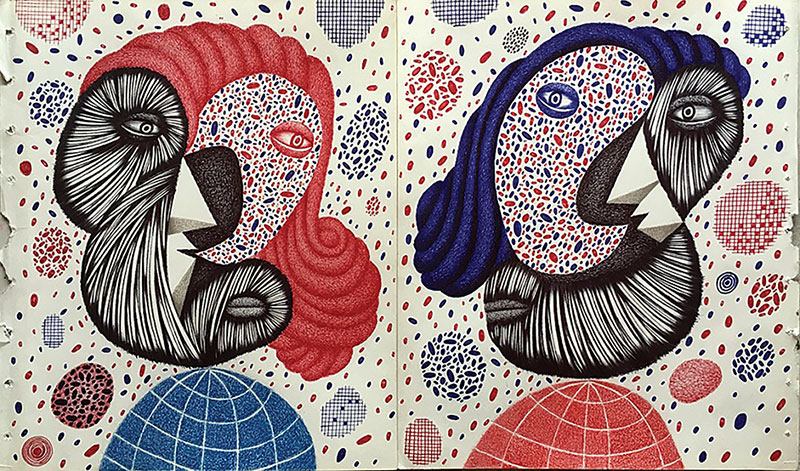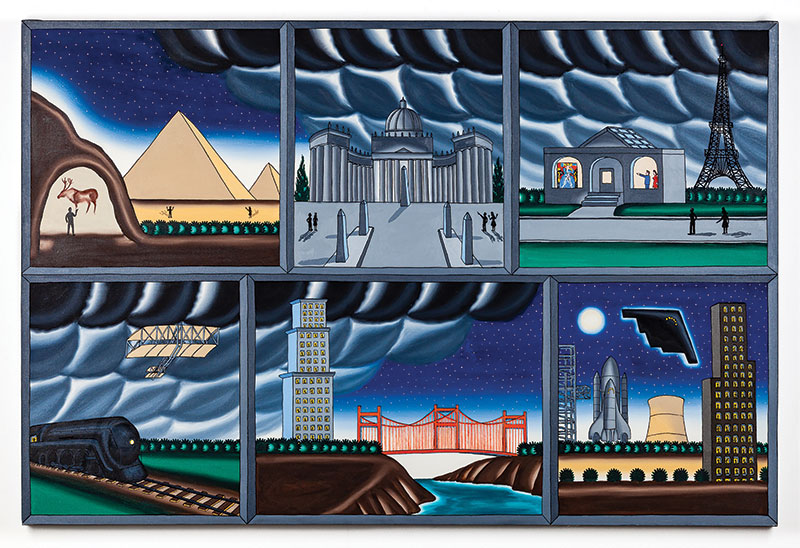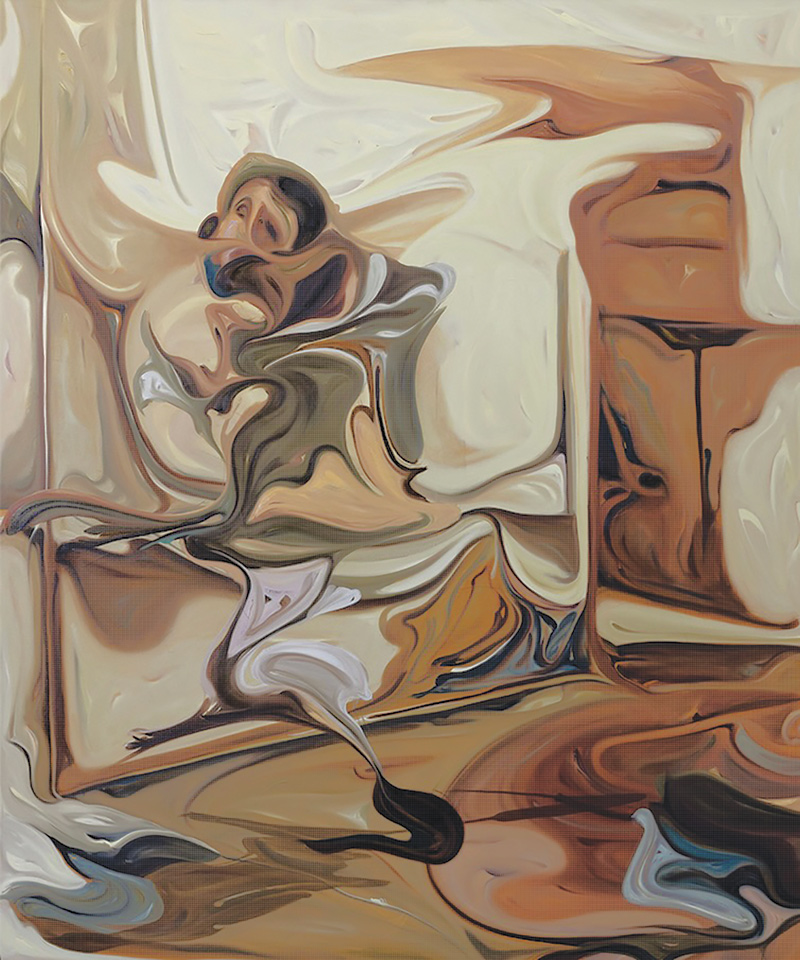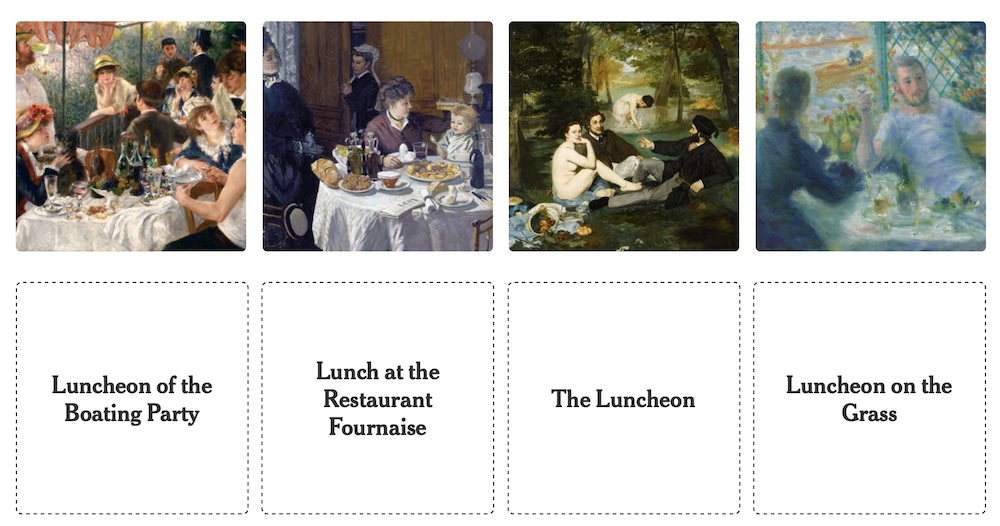Mirror, Mirror on the Gallery Wall: After This Year, Who Can Predict 2021?


By GINNY VAN ALYEA
Fall is just beginning, but I’m sure no one can blame me for desperately looking forward to a new year. I won’t hold my breath that 2021 will be a totally fresh start, but I truly hope it will be healthier, safer, more tolerant and less violent than 2020 so far in Chicago and the world. I also wish for a more routine return to connecting in person, though it’s clear that virtual events and working from home are here to stay just as much as reservations and timed entries.
Like many others, I see two main scenarios that could shape up in the year ahead: Life with a vaccine, and life without. While one occupies my thoughts more than the other, I wanted to find out what others in the art community are thinking right now as we balance multiple safety as well as business and civic needs. It’s impossible to ignore the current stunning state of the city, country and society compared to a few months ago.
My questions seek everyone’s best guess. What harm is it to take a pretend gamble right now? Responses are grouped by topic. I am grateful to those who candidly shared their collective wisdom and hope for the future as we wade through an unpredictable time.
ON A TIME WITHOUT
CGN: Regarding art, what do you think most people took for granted before the pandemic?
Jason Pickleman, designer, collector, dealer, oracle:
I can’t speak for all, but I took for granted an artwork’s physicality—the life of its dimensionality—in my appreciation of art. Looking at the side of a stretched canvas, and walking around a sculpture is where the action is (was).
John McKinnon, Director of Elmhurst Art Museum:
It’s hard to identify just one thing because our lives have been affected in so many ways. What we previously counted on, from world financial systems to simple shared experiences, have turned upside down. It’s incredible to learn how fragile these systems truly are.
After they come back, shared group experiences will be more treasured in the next few years. As a parent, I can’t help but think about how young children don’t know they can climb on a playground and play with other children. For those of us that know better, I think we’ll appreciate group events even more—especially joyous events like weddings or birthdays. I’m personally looking forward to attending live concerts again.
Rebecca Woan, Chartwell Insurance:
I thought pandemics were the content for Hollywood movies, and I thought that the sophisticated resources of the government and health systems would protect us as they had for Ebola, and to a certain degree Zika [virus].
Bianca Bova, curator:
Prior to the pandemic, I think the accessibility of art viewing was taken for granted. You could spend an entire day in any museum on a whim, or stop into a half dozen galleries in without giving it a second thought. No appointments, no limited time slots, no advanced planning required.
Claudine Isé, owner, Goldfinch:
Everyone’s situation is different. I know for myself this is a difficult question to answer.The phrase “taking for granted” seems to imply that there were some things that we didn’t quite deserve to have in the first place, and through our own hubris or neglect we lost them. In the United States this pandemic did not need to spread as quickly and as virulently as it has, and the fact that it did is due to the failures of our current government regime. Nobody deserves this. We do deserve to have everything we lost given back to us, ASAP.
VIRTUAL UNREALITY?
CGN: What do you envision as far as the virtual art world?
Jason Pickleman:
Digital spaces will continue to professionalize, both in terms of quality of display and in levels of monetization.
John McKinnon:
Whether offline or online, we are storytellers. Our profession has developed innovative ways to weave tales about collection materials, artists, exhibits, architecture, etc. We’ve seen a new wave of online materials and will see more. It is hard to predict how things will change beyond the last five months, but I believe we’ll see more materials like our Museum From Home initiative. Online components like these add to museum visits as educational resources and a preview for a physical exhibit.
Rebecca Woan:
I’m answering this looking forward over the next 12-24 months. The optimist in me would like to see virtual as a bridge between the in-person world with the ability to both live stream and conduct in-person events. My hope is that once it’s safe to emerge people will want to leave their screens and not permanently retreat to them.
Bianca Bova:
I think of the virtual art world as a tool and not a place. It’s a tool I’m grateful we’ve had at our disposal in the last six months, and I think as an industry we’ve made strides in how it’s effectively used. I hope some of that is here to stay.
Claudine Isé:
Goldfinch, like everyone else, is shifting exhibition content online in order to reach as many people as possible, and that has been a good thing for us. But I don’t like “virtual” spaces at all and have felt really disheartened at the quickness with which art fairs have moved to the virtual space. I was looking at a virtual art fair this last week and I thought the artwork looked terrible — the effect of these types of digitized spaces is that they make the artworks, including paintings, look purely digitized too. I guess my vision is more authentic online content (filmed interviews and live online panel discussions, along with crisp, high resolution artwork documentation, etc. and less (or even no) “virtual” spaces that feel like video games but don’t look half as good and are nowhere near as fun.

REMEMBER THE FAIRS?
CGN: Do you think art fairs will continue to take place? What will be the biggest difference to how they operate in a COVID/post-COVID world?
Jason Pickleman:
Art fairs are conventions, no different than the Chicago Auto Show. Car manufacturers still produce cars; people still purchase them. Same with art. Artists will continue to produce art, and galleries will continue to be the primary outlet for acquisition. Art fairs will acknowledge that primary motive with more transparency and less ancillary event programming. Good bye to the bodily crush of Opening Night (or recently, Opening Afternoon if you were a VIP). After parties on boats? Well that was fun. Sort of.
John McKinnon:
It will take time, but I think art fairs will still take place. I believe people are craving group events, whether going to the movies, playing mini golf with other families, or seeing a show. I believe we will see more of this with time because staying indoors has affected many people’s mindsets and mental health.
Rebecca Woan:
Art fairs will undergo some evolution, which isn’t necessarily a bad thing. They may be able to reach more people than ever however it seems to me that for many collectors the art fair is as much about the experience as the purchase and that has been lost in the current time.
Bianca Bova:
Art fairs will continue to take place. Apart from the obvious additional protocols--hand sanitizer stations, masks, social distancing at cafes and lectures--I’m not sure there will be, or needs to be, significant operational differences. There will always be art, and there will always be people to buy art, and fairs are still an ideal place to do that.
Claudine Isé:
Yes they will continue to take place because most galleries haven’t figured out a way to survive without them. Hence the virtual art fairs that look like video games.
LET’S GO CRAZY
CGN: What’s your craziest prediction (or wish or fear) for the art community in the future?
Jason Pickleman:
In the 1970s, artists’ collectives came together and started their own peer-to-peer gallery spaces. N.A.M.E. Gallery, ARC, Artemisia, and Randolph Street Gallery (to name but four here in Chicago). These grungy spaces became vital outlets for artists (hello Jerry Saltz! You turned out OK!). Artist run spaces have continued to arise and proliferate on shoestring budgets: Heaven Gallery, Roots & Culture, Roman Susan, for example. The art boom of the past four decades pushed the visibility of these venues into the shadows of the publishable (and commercially venerated) side of the art world. The upcoming Hyde Park Art Center’s exhibition Artists Run Chicago 2.0 is a rebuke (and testament) to the elevation of artists working for and with artists as the cornerstone of art’s journey. Imagine if any of these spaces could sell work at the price level of a Corbett vs. Dempsey or a Rhona Hoffman without the obligatory hand-wrangling and inebriation of their annual galas or benefits?
John McKinnon:
Our value system in art has and will continue to change, much like we’ve re-evaluated our own personal priorities during this horrible pandemic. I’d like to see less duct-taped banana stunts and more meaningful dialogue in the art world.
Rebecca Woan:
The art community is becoming more diverse, and more democratic, as there is an audience willing to hear about injustices, so I don’t think this is a prediction because it is happening. I hope the momentum continues. However, I have a fear, shared by many: the art world relies heavily on financial support and we need robust wealth creation to continue that support. We don’t know yet how recovery will look once the government stops pumping money into the economy, or whether we will see rampant inflation in the future as a result of the debt creation. How will those trickle-down effects manifest themselves? Time will tell.
Bianca Bova:
My wish for the art world is that it returns to being about the art – no agenda, no gatekeeping, no priorities beyond identifying great art and venerating it.
Carl Hammer, owner, Carl Hammer Gallery:
The art world is certainly part of the “cement” that seems to help hold the Earth and our lives together. 2020/2021 promises to be both challenging and eventful, testing all of our collective/creative willpower and efforts to keep things on track. Things will change for both good and bad in the art world. Yet, in my mind, we are privileged to be associated with an industry in which one’s imagination makes the impossible happen. To that end, the year(s) ahead will depend on those of us who best see “the light at the end of the tunnel.”
Claudine Isé:
I don’t usually think much about predictions. I guess that my wish is that the human vulnerability that the pandemic brings out in us all, and which is something that we can see, appreciate, witness in one another as a community and empathize with, can be carried through to larger structural conditions and systems once pandemic conditions have lessened. Is there a way we can come out the other end and find ourselves building an art world that its more equitable and just, more humane, less greedy and less racist? My wildest hope is that that could be the case.

WHAT ART MIGHT COME NEXT
CGN: Do you see any artistic inclinations or trends ahead? In subject, medium, placement, or collaborations?
John McKinnon:
Many conversations are happening during this transformative time in America that will affect artistic output. Recent events remind us that for all the progress we have made, we still have more work to do against social and racial injustices. We are in the middle of a history-altering human rights movement reignited by tragic deaths of George Floyd, Breonna Taylor, and too many others. Because of the spread of the Black Lives Matter movement Confederate statues have toppled, sports players are kneeling, other voices are gaining strength, and we will continue to see messages in many art forms. More people than ever before – including artists and institutions – are committed to asking difficult questions, learning from each other, and shaping a more equitable future.
Rebecca Woan:
Artists during shelter in place have creatively adapted to the medium that video allows for visual arts. The alienation has been amplified by social unrest, which has engaged many more people. We will see this reflected in art for quite a while I’m sure.
Bianca Bova:
Being away from galleries, museums, and fairs has left me hungry for work that is especially nuanced. I see renewed interest especially in painting and in fiber art – work that requires close inspection, that reveals itself slowly and fully only when you’re in front of it.
Claudine Isé:
It’s too early to see artistic trends — artists are still struggling to maintain, not to mention access, studio spaces. Mental health issues related to the pandemic in some cases slow things down. I suspect most artists are still in the “How do I get through this?” stage. Perhaps, though, there could be slight shifts in medium to that which is closest at hand, like paper, collage materials, etc., and artists working on a more “domestic” scale, because so many artists have needed to move their studio home.
Jason Pickleman:
I wrote a poem during the financial crash of 2008, which I’ll let speak to the present moment:
After money has run its course /
and the empty spaces of its transactions are hollowed and barren /
a vacuum of dreams processed and fulfilled /
when display is displaced /
after the last deduction and the final reduction /
have left the shelves barren sans function /
and emptiness reigns /
so then, /
the lofts of tomorrow are the strip malls of today.






